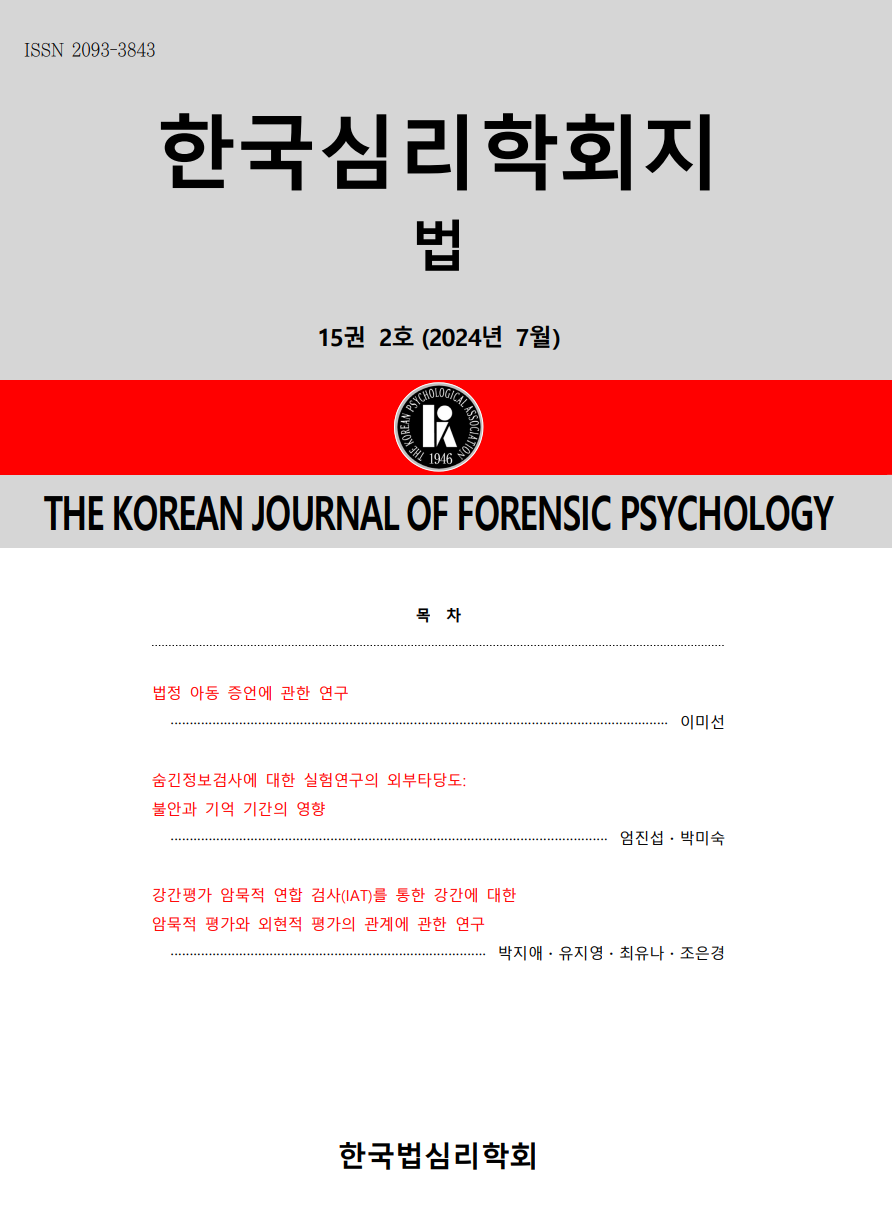open access
메뉴
open access
메뉴 ISSN : 2093-3843
ISSN : 2093-3843
This study deals with a Bayesian approach in interpreting eyewitness statement data. The Bayesian approach has the advantage of being able to elucidate real world investigation and trial. The main purpose of this study is to summarize a series of research trials to prove these advantages. Wells & Lindsay(1980) are first research to take this approach. They newly invented the information gain model and this Bayesian formula proves that identification failure, such as false identification or inability to identify lineup participants also has diagnosticity which reduces suspect's probability of being a culprit. Wells & Turtle(1986) used the same information gain model context and analysis methodology, and suggest using the single-suspect model instead because the likelihood of false identification errors inherent in the all suspect model is higher when compared to the single-suspect model. Wells & Olson(2002) found that among the major system variables dealt with in eyewitness psychology, the contrasting effect of sequential lineup vs. simultaneous lineup and the effect of the lineup participant selection method were explained in the information gain model. Clark & Wells(2008) attempted to analyze the effect of identification response from two or more witnesses who witnessed an one culprit in the lineup based on diagnosticity indicator. My research integrate multiple evidences of guilty or not guilty to refer to implications of this study, and then examines the functional relationship that yields the final post-guilt probabilities. Wells, Yang, & Smalarz(2015) newly devised Base-Rate Effect-Equilvalency(BREE) curves as emphasizing that prior probability(base rate) is a very important system variable as it has been confirmed based on information gain model through Bayesian approach. In addition, it suggested that a new standard of “reasonable suspicion” is required as a legal premise for the lineup structure in order to prevent misjudgement due to system variables such as lineups.
김상준 (2013). 무죄판결과 법관의 사실인정. 서울대 박사학위논문
Clark, S. E. (2012). Costs and benefits of eyewitness identification reform psychological science and public policy. Perspectives on Psychological Science, 7(3), 238-259.
Clark, S. E., & Wells, G. L. (2008). On the diagnosticity of multiple-witness identifications. Law and human behavior, 32(5), 406.
Honts, C. R., & Schweinle, W. (2009). Information gain of psychophysiological detection of deception in forensic and screening settings. Applied psychophysiology and biofeedback, 34(3), 161-172.
Innocence Project. (2015). 2015. 12. 23. 방문http://www.innocenceproject.org/
Loftus, E. F. (1976) Unconscious transference in eyewitness identification, Law and Psychology Review, 2, 93-98
Loftus, E. F. (1979). Eyewitness testimony. Cambridge, MA: Harvard University Press.
Memon, A., Hope, L., & Bull, R. (2003). Exposure duration: Effects on eyewitness accuracy and confidence. British Journal of Psychology, 94(3), 339-354.
Wells, G. L. (1978). Applied eyewitness testimony research: System variables and estimator variables. Journal of Personality and Social Psychology, 36, 1546-1557.
Wells, G. L. (1984). The Psychology of Lineup Identifications1. Journal of Applied Social Psychology, 14(2), 89-103.
Wells, G. L., & Lindsay, R. C. L. (1980). On estimating the diagnosticity of eyewitness non-identifications. Psychological Bulletin, 88, 776-784.
Wells, G. L., & Olson, E. A. (2002). Eyewitness identification: information gain from incriminating and exonerating behaviors. Journal of Experimental Psychology: Applied, Vol 8(3), Sep 2002, 155-167.
Wells, G. L., & Turtle, J. W. (1986). Eyewitness identification: The importance of lineup models. Psychological Bulletin, 99, 320-329.
Wells, G. L., Yang, Y., & Smalarz, L. (2015). Eyewitness identification: Bayesian information gain, base-rate effect equivalency curves, and reasonable suspicion. Law and human behavior, 39(2), 99.
Wright, D. B., & McDaid, A. T. (1996). Comparing system and estimator variables using data from real line-ups. Applied Cognitive Psychology, 10(1), 75-84.
Yuille, J. C., & Tollestrup, P. A. (1992). A model of the diverse effects of emotion on eyewitness memory. The handbook of emotion and memory:Research and theory, 201-215.